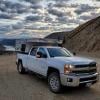Hey gang - I wanted to share the progress of a solar install and request feedback on some ideas. Thanks in advance.
There was a positive and negative wire in the battery compartment of my 2017 hawk labeled 'solar battery'. After searching around in the cabinets near the water heater and by the fuses with no luck, I discovered the coiled solar wires behind a panel directly below the sink and was thrilled they were so easy to access. The intent of FWC must have been to mount the controller in this area.
The 'rear solar' and 'roof solar' wires were connected via a push-in connector (I'm not sure of the connector name) with a single positive and negative wire exposed. There were also two wires not connected to anything, which I assume are the end of the 'solar battery' wires in the battery compartment.
I do not want to have my solar controller directly below the sink, so I'm going to run the wires down to the battery box where I'm going to mount a Victron MPPT solar controller. Here are my questions.
1. The positive solar wire that will connect to the solar controller has a fuse. Do I need to keep this inline fuse?
2. The positive battery wire that will connect to the solar controller has a fuse. Do I need to keep this fuse?
To note, the MPPT has a fuse. I am aware of the reversed polarity of the wiring due to the Zamp connection, so I am going to make sure of the polarity and if I need a fuse in the wire, I'll install on the positive wire.
I mounted the Renogy 100w panel to a piece of angle aluminum, and will mount the aluminum to the Yakima tracks. I used mounting brackets for a little extra space. I like the set up and ease of removal, and owe a few folks on the forum a thanks for the description and photos of their set-up.


















